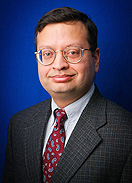News
UB shares additional $2.5 million award
to help U.S. military process data
-
 Print
Print -
 Comments
(1)
Comments
(1)
-

Rakesh Nagi and colleagues have been awarded grants totaling $6.5 million from the Army Research Office to develop tools that help the U.S. military process massive amounts of data.
Researchers from UB and elsewhere will receive $2.5 million to develop tools that help the U.S. military process massive amounts of data and improve national security.
Department of Defense agencies gather data from many sources, including remote satellites, unmanned aerial vehicles and observations made by soldiers. Because so much data is being collected at any given time, it can be difficult to streamline the data into coherent and valuable information.
Under a grant issued in 2009 by the Army Research Office, researchers at UB, Pennsylvania State University, Tennessee State University and Iona College are developing computer models and other techniques that fuse the data together. Part of the Army’s Multidisciplinary University Research Initiative, or MURI, the initial award was for $3.75 million over three years. The Army recently extended the grant by two years for a total of $6.25 million.
Researchers classify data into two categories: “hard” and “soft.” Hard data includes, but is not limited to, video and sound recordings, and tracking devices such as radar. Soft data includes anonymous phone calls to police, observations made by soldiers, local media reports and other sources.
“The diverse and massive amounts of data being collected can sometimes result in conflicting information. We are developing methods that will help intelligence analysts to accurately correlate that information,” says Rakesh Nagi, professor and chair of UB’s industrial and systems engineering department, who is leading eight UB researchers working on the project.
The computer models, algorithms and other techniques developed by the researchers could be useful for other government agencies, such as the Department of Homeland Security and CIA, as well as have business applications.
UB’s portion of the research is being conducted through the university’s Center for Multi-Source Information Fusion Research. Operated jointly with CUBRC, an independent not-for-profit company in Buffalo, the center was created in 2006 with a $1 million Defense Department grant. CUBRC was formed in 1983 by UB and the former Calspan Corp.; its mission is to generate technological and economic growth in Western New York through a variety of research and development programs.

Reader Comments
Jim Holstun says:
CUBRC lists one of its specialties as "chemical and biological defense." http://www.cubrc.org/WebModules/Content/About.aspx. Two questions:
1. How would the US conduct research in new ways to wage chemical and biological warfare--wouldn't it be under the heading of "chemical and biological DEFENSE," as our Department of War has now become our Defense Department?
2. What's the difference between chemical and biological warfare and "weapons of mass destruction"?
3. If the answer to 1 is "yes" and the answer to 2 is "there is no difference," then would Iraq have the right to wage war on Buffalo, as Buffalo and the US claimed the right to wage war on Iraq under the (false) charge that it was developing weapons of mass destruction?
Posted by Jim Holstun, Professor of English, 07/16/12